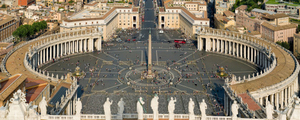The difference between the Catholic version of the Bible and other translations is that it has additional books contained in the Old Testament that other translations (NKJV, NIV, etc.) do not.
These added books in the Catholic Bible are known collectively as the Apocrypha. They include such books as Tobit, Judith, 1 and 2 Maccabees, etc. The Jews did not preserve these books down through the centuries, but certain Christians preserved them, seeing them as having spiritual value.
The Jews, as well as Protestants (which use the same canon of the Old Testament), deny that they are inspired by God or have binding spiritual authority. The Roman Catholic Church felt otherwise, and made them officially part of the canon of Scripture at the Council of Trent in the sixteenth century. This Catholic council is famous for its response against charges brought against the church primarily from the Protestant Reformation.

Early in the history of these books, indeed before the Roman Empire fell (476 A.D.), two of the leading Catholic writers, Jerome and Augustine, had a major debate over the Apocrypha.
Jerome, who translated much of God's word into Latin for the Roman church (the Latin Vulgate version), denied the Apocrypha was inspired. Augustine felt otherwise, and believed them to have canonical authority. However, Augustine's position did not win out officially until over a thousand one-hundred years after his death.
Some of the many problems with the Apocrypha are its absurd stories, historical errors and contradictions. The literary quality simply isn't very good, and they fail what (say) Josh McDowell might call the "internal evidence" test. You may find it worth tracking down his book "The New Evidence That Demands a Verdict" for further research in the area of Christian apologetics, or his "More Than a Carpenter."
An Example
Tobit, which the Catholic Church accepts, describes a story in which a Jewish father, blinded by bird's dung falling into his eyes, sends out his son to collect a debt. He gets a heart, liver, and gall of a fish on his journey. He runs into a widow who has married seven times, but had never consummated any of these marriages with her husbands because an evil spirit had killed each husband on their respective wedding nights.
Tobias (the son) marries this widow, and by burning two of the fish parts, drives off the evil spirit called Asmodeus. He then uses the gall from that fish to cure his father's blindness. If one is familiar with the canonical Old Testament books, one should then see how absurd the setting and miracles of this story are by comparison.
There is also a historical error in Tobit, the Catholic accepted book, concerning the age of the father, who would have to be well over 200 years old to have experienced personally the deportation of Israel to Nineveh by the Assyrians, but he is only 102 years old when he dies. This book lacks what C.S. Lewis might call "fitness," or overall appropriateness. It is more superstitious than Godly.
Judith's Absurd Book
Another Apocrypha writing, the book of Judith, contains so many absurdities that even another Catholic translation admitted, "The book of Judith in particular shows a bland indifference to history and geography."
The traditional Christian scholar Bruce Metzger, in "The Canon of the New Testament: Its Origin, Development, and Significance," gives three basic guidelines that the early Christians used for determining their own canon. The first guideline was agreement with the "rule of faith," or general traditional Christian teaching. The second was a general, long-standing usage among many congregations. The final guideline was apostolic authorship, which inevitably led to the exclusion of post-100 A.D. writings.
These added books in the Catholic Bible are not inspired. One can find demonstrable historical errors in them that are nearly impossible to explain away. I would not want to say 2Maccabees is as historically sound as (say) either the books of Daniel, 1Kings or 2Kings.